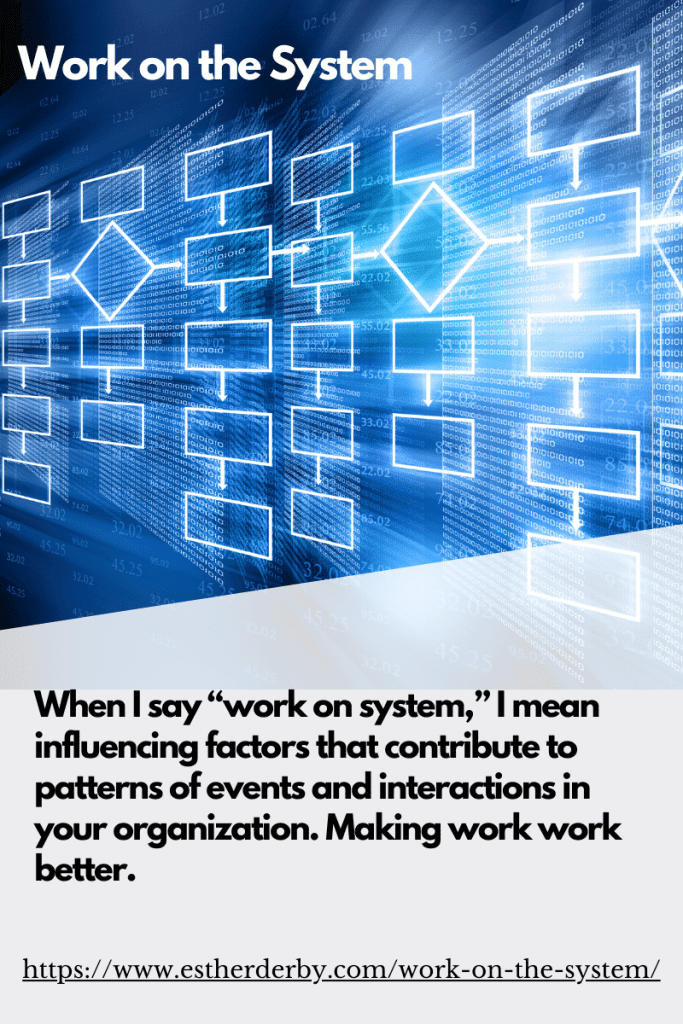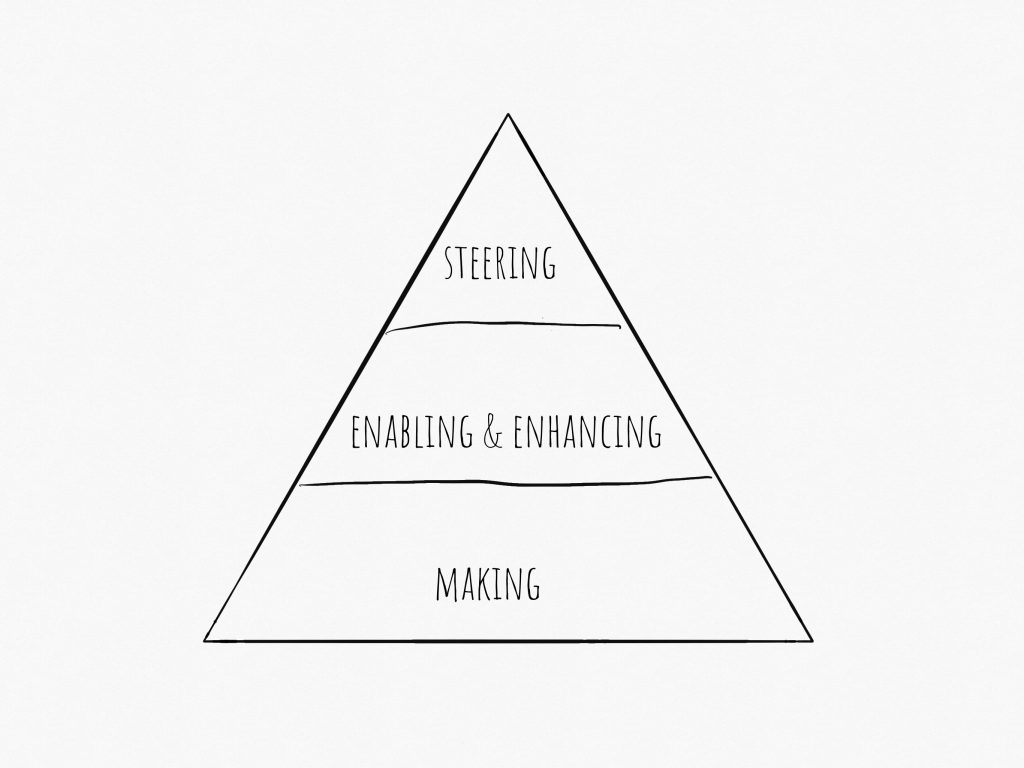When I say “work on system,” I mean influencing factors that contribute to patterns of events and interactions in your organization. Making work work better. So, how do you work on the system?
Attend to creating an environment where great work is a likely outcome—and easy. The problems we need to solve for customers are hard enough. No need to make it harder with a bad system.
Influence system patterns by attending to Clarity, Conditions, and Constraints.
Clarity
People know how their work fits into the big picture.

That implies understand the context. They know who the customer is, and what problem the product or service solves.
They have (at least) a basic understanding of the market they are in and the revenue model for their product. This is key to enabling ppl to make reasonable decisions within the bounded autonomy (I’ll get to that in a bit).
This may seem obvious. However, as companies grow, knowledge tends to bifurcate. In my experience, this begins far earlier than you might thing—when the company grows past 30 or so people. Bifurcation leads to patterns of distrust and poor decisions. People on both sides of the divide lack critical information for decisions.
People know what to work on next. This doesn’t mean having a three year plan or even one year plan. People need a general understanding of direction, and a more nuance understanding of what is coming in the next weeks (maybe months).
On the team level, it might be knowing what story is the next priority, or which item is at the top of the queue.
Clarity enables patterns of coherent action across the organization. Contextual understand supports initiative–people don’t have to wait to be told what to do. It speeds decision-making as people closer to the work have the information to make more decisions in a reasonable way. Clarity reduces the need for supervision.
In my experience, you have to work much harder on clarity in remote situations. And, it is much more important to enable coherent action when osmotic communication isn’t possible.
Conditions
People have the means and environment to do their work. They have a clear goal (see above) and the skills, material, tools, and monetary resources to accomplish the goal.
Right now, that includes access to online collaboration tools, decent internet access, webcams, etc. Can your company provide a subsidy to help ppl upgrade their home rigs? Do it.
Is your company blocking access to online tools out of caution? Work with the powers that be to find an acceptable alternative. Involve your manager in making the case.

Don’t expect people to be effective at remote work without /robust/ technology tools. Just don’t. Don’t expect people to be on video meetings all day. It is exhausting.
Work flows into teams smoothly, based on capacity.
Smoothing the flow of work, organizing work and teams to reduce dependencies and handoffs, is management work. It might look different now than it did in before the pandemic.
My guess is most teams are doing their best, and not at peak capacity. Adjust plans based on current capacity. Plans that don’t take known capacity into account are wishful thinking. And sometime abuse.
Organizational structures and policies must support the work.
If they’re organized a team, they really are a team. If they need to work cross-functionally, they’re organized to reduce hand-offs and dependencies.
Job descriptions, career ladders, rewards and other structures support how the organization says they want people to work. So managers aren’t telling people they want collaboration and then focusing exclusively on individual accomplishments and rewards. Or asking for people to take initiative and having elaborate approval processes.
When what is asked for is at odds with what is rewarded, the gap between the two fills in with cynicism. When managers exhort people to meet important deadlines, but fail to provide the means to do the work, trust erodes.
Constraints
There are constrain that hamper flow, and constraints that dampen flailing. Both are important. For now I’m focused on the second kind.
Constraints can seem rather abstract and esoteric. However, we deal with constraints all the time in every day life. However, we don’t name them that way. There are constraints that say what must always and never be done. For example, mandating that all projects must use VB 6.0 (:scream:). Other constraints establish bounded autonomy. Such constraints set a perimeter, within which you have freedom to act. These sorts of constraints can lead to astounding creativity. If you’ve read poetry, you are familiar this: sonnets, limericks, haiku…
Constraints help people know what behavior is always expected and never tolerated. (This little article focuses at the team level, but companies have norms, too, and Simple Rules function at many levels )
Constraints help people know which decisions they can make and which require a conversation.
Here’s an analogy. For a while, my neighbors had an “invisible fence” that was, in fact visible–just lying on the ground. On a windy day, the wire could move several feet. Their poor dog was afraid to leave the porch because he never knew where the shock would hit.
Don’t be like that.
(They are quite nice actually, and now have a physical fence, that keeps the dog in and the neighborhood bears and foxes out.)
Making constraints explicit by means of conversation has a double effect. It establishes the boundary, but also models that the discussion is possible. Sometimes it is worth relaxing the constraint for greater benefit. For example, I had a budget for my kitchen remodel. The designer presented three options. One on budget, one below, one above. The first two options would have been an improvement. The third, more expensive option, transformed the social space of the house. I found the extra money.
When people bump up against an explicit constraint, they can talk about it. This bolsters an environment of psychological safety.
In a System, Everything Touches Everything
If you shift any one of these things, you are likely to see differences across the system. That’s the nature of systems–everything touches everything. Working on the system doesn’t require massive change or top down authority. A small change to one factor can have broad influence across the organization. Start where you are. Do what you can.
Listen to my pod on the topic.







Great read.
Note typo: “ Work flows into teams in smoothly based on capacity. ”
Glad you found it valuable.
Typo fixed. Thanks!